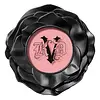What's inside
What's inside
 Key Ingredients
Key Ingredients

 Benefits
Benefits

 Concerns
Concerns

 Ingredients Side-by-side
Ingredients Side-by-side

Talc
AbrasiveMica
Cosmetic ColorantDimethiconol Stearate
EmollientCaprylic/Capric Triglyceride
MaskingPolymethyl Methacrylate
Aluminum Hydroxide
EmollientDimethicone
EmollientTrimethylsiloxysilicate
EmollientCaprylyl Glycol
EmollientPhenoxyethanol
PreservativeMagnesium Myristate
Hexylene Glycol
EmulsifyingCI 77120
Cosmetic ColorantCI 77007
Cosmetic ColorantCI 15850
Cosmetic ColorantCI 19140
Cosmetic ColorantMica
Cosmetic ColorantDimethicone
EmollientCaprylic/Capric Triglyceride
MaskingTapioca Starch
Dimethicone/Vinyl Dimethicone Crosspolymer
Skin ConditioningMicrocrystalline Cellulose
AbsorbentSilica
AbrasiveDiamond Powder
AbrasiveKaolin
AbrasiveSynthetic Fluorphlogopite
1,2-Hexanediol
Skin ConditioningCaprylyl Glycol
EmollientEthylhexylglycerin
Skin ConditioningDehydroacetic Acid
PreservativeXanthan Gum
EmulsifyingPolymethylsilsesquioxane
Tin Oxide
AbrasiveTocopherol
AntioxidantTitanium Dioxide
Cosmetic ColorantCI 77163
Cosmetic ColorantIron Oxides
CI 15850
Cosmetic ColorantCI 77007
Cosmetic ColorantMica, Dimethicone, Caprylic/Capric Triglyceride, Tapioca Starch, Dimethicone/Vinyl Dimethicone Crosspolymer, Microcrystalline Cellulose, Silica, Diamond Powder, Kaolin, Synthetic Fluorphlogopite, 1,2-Hexanediol, Caprylyl Glycol, Ethylhexylglycerin, Dehydroacetic Acid, Xanthan Gum, Polymethylsilsesquioxane, Tin Oxide, Tocopherol, Titanium Dioxide, CI 77163, Iron Oxides, CI 15850, CI 77007
Ingredients Explained
These ingredients are found in both products.
Ingredients higher up in an ingredient list are typically present in a larger amount.
This ingredient is an emollient, solvent, and texture enhancer. It is considered a skin-softener by helping the skin prevent moisture loss.
It helps thicken a product's formula and makes it easier to spread by dissolving clumping compounds.
Caprylic Triglyceride is made by combining glycerin with coconut oil, forming a clear liquid.
While there is an assumption Caprylic Triglyceride can clog pores due to it being derived from coconut oil, there is no research supporting this.
Learn more about Caprylic/Capric TriglycerideCaprylyl Glycol is a humectant and emollient, meaning it attracts and preserves moisture.
It is a common ingredient in many products, especially those designed to hydrate skin. The primary benefits are retaining moisture, skin softening, and promoting a healthy skin barrier.
Though Caprylyl Glycol is an alcohol derived from fatty acids, it is not the kind that can dry out skin.
This ingredient is also used as a preservative to extend the life of products. It has slight antimicrobial properties.
Learn more about Caprylyl GlycolCi 15850 is the pigment color red. It is an azo dye and created synthetically.
Azo dyes need to be thoroughly purified before use. This allows them to be more stable and longer-lasting.
This ingredient is common in foundations, lipsticks, and blushes. This color is described as brown/orangey red.
It has many secondary names such as Red 6 and Red 7. According to a manufacturer, Red 6 usually contains aluminum.
Learn more about CI 15850This pigment is called Ultramarine blue lazurite. It gives a saturated blue color, but can be used to create other colors as well.
According to the manufacturer, it is usually made from kaolin, sodium sulfate, sodium carbonate, sulfur, and charcoal.
Dimethicone is a type of synthetic silicone created from natural materials such as quartz.
What it does:
Dimethicone comes in different viscosities:
Depending on the viscosity, dimethicone has different properties.
Ingredients lists don't always show which type is used, so we recommend reaching out to the brand if you have questions about the viscosity.
This ingredient is unlikely to cause irritation because it does not get absorbed into skin. However, people with silicone allergies should be careful about using this ingredient.
Note: Dimethicone may contribute to pilling. This is because it is not oil or water soluble, so pilling may occur when layered with products. When mixed with heavy oils in a formula, the outcome is also quite greasy.
Learn more about DimethiconeMica is a naturally occurring mineral used to add shimmer and color in cosmetics. It can also help improve the texture of a product or give it an opaque, white/silver color.
Serecite is the name for very fine but ragged grains of mica.
This ingredient is often coated with metal oxides like titanium dioxide. Trace amounts of heavy metals may be found in mica, but these metals are not harmful in our personal products.
Mica has been used since prehistoric times throughout the world. Ancient Egyptian, Indian, Greek, Roman, Aztec, and Chinese civilizations have used mica.
Learn more about Mica